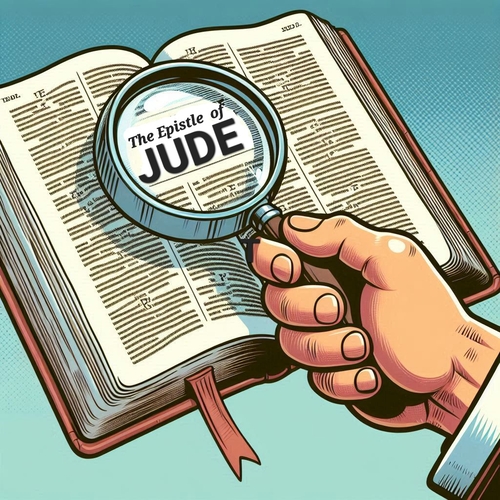Does Jude Belong in the Bible?
ANSWERING OBJECTIONS TO THE EPISTLE’S CANONICITY
At just 25 verses, the epistle of Jude packs more controversy per word than perhaps any other New Testament book. Early church historian Eusebius labelled it among the “disputed books.” Some modern scholars question its authorship. Critics point to its quotations from non-biblical sources as problematic.
So does the brief letter really belong in our Bibles? The Reformed tradition offers compelling reasons to answer with a resounding yes.
THE HISTORICAL CHALLENGE
The scepticism isn’t entirely unfounded. Unlike Romans or the Gospels, Jude faced early resistance in some quarters. Eastern churches were slower to accept it. Manuscript evidence, while present, isn’t as abundant as for other New Testament books.
But hesitation doesn’t equal rejection. Even disputed books could be genuinely apostolic, as the early church recognised. The question isn’t whether some doubted Jude initially, but whether the doubts were justified.
FIVE PILLARS SUPPORTING JUDE’S CANONICITY
Apostolic Authority: Jude identifies himself as “a servant of Jesus Christ and brother of James” (v. 1). The humble self-description points to Jude, the brother of Jesus mentioned in Matthew 13:55 and Mark 6:3. Rather than claiming apostolic status directly, he grounds his authority in his relationship to James, the respected leader of the Jerusalem church.
The epistle’s tone confirms this authority. Jude writes with the confidence of one commissioned to defend “the faith once delivered to the saints” (v. 3). Early Christian writers like Clement of Rome and Origen recognized this apostolic character, and key manuscripts like Codex Sinaiticus and Vaticanus include Jude without hesitation.
Doctrinal Orthodoxy: Far from teaching anything questionable, Jude reinforces core Christian truths. He affirms salvation by grace (v. 3), warns against antinomianism (v. 4), exalts Christ as Lord and Saviour (vv. 4, 17, 21, 25), and presents a thoroughly Trinitarian framework throughout.
The epistle’s theology aligns perfectly with Paul’s letters and echoes themes from 2 Peter. This isn’t the work of a later heretic or confused pseudepigrapher—it’s orthodox Christianity at its finest.
Prophetic Insight: Jude demonstrates supernatural insight into the nature of apostasy and false teaching. His predictions about ungodly infiltrators (vv. 17-19) read like a blueprint for church history’s recurring heresies. This prophetic dimension suggests divine inspiration, not merely human wisdom.
The epistle’s spiritual warfare perspective—including detailed knowledge of angelic rebellion—reflects the kind of revelation we’d expect from someone in apostolic circles.
Providential Preservation: Despite early questions, Jude survived the rigorous process of canonical recognition. The church’s gradual acceptance wasn’t due to political manoeuvring but to growing recognition of the epistle’s divine authority and practical necessity.
The Protestant Reformers unanimously included Jude in their biblical canons. The Westminster Confession lists it without qualification among the canonical books. This wasn’t mere tradition but theological conviction based on careful examination.
Unique Necessity: Jude fills a crucial gap in the New Testament’s warning system. While other epistles address false teaching, none matches Jude’s urgent, comprehensive treatment of apostasy’s patterns and dangers. The epistle provides tools for discernment that the church desperately needs in every generation.
Its brevity isn’t a weakness—it’s a strength. Like Philemon and 3 John, Jude proves God’s Word is efficient, packing maximum truth into minimal space.
ADDRESSING COMMON OBJECTIONS
“Jude Quotes Non-Biblical Sources”: The strongest objection centres on Jude’s quotation from 1 Enoch (vv. 14-15) and possible reference to the Assumption of Moses (v. 9). Critics argue citing apocryphal books undermines biblical authority.
This objection misunderstands how inspiration works. Paul quoted pagan poets in Acts 17:28 and 1 Corinthians 15:33, but this doesn’t canonise Greek philosophy. Similarly, Jude can cite true statements from non-canonical sources without endorsing those sources entirely.
The principle is simple: truth remains truth regardless of its source. Jude, under divine inspiration, selected what aligned with revealed truth while ignoring what didn’t. This demonstrates spiritual discernment, not careless borrowing.
“The Authorship Is Uncertain” : Some scholars propose “Jude” is a pseudonym used by a later writer. But this theory lacks compelling evidence. The epistle’s internal characteristics—its humble tone, Jewish background, and early church setting—fit perfectly with authorship by Jesus’ brother.
Moreover, early Christian literature consistently identifies the author as Jude, brother of James. Alternative theories create more problems than they solve.
“It’s Too Short to Be Significant”: This objection reveals a misunderstanding of biblical authority. God’s Word isn’t validated by length but by divine inspiration. Would we exclude Philemon or 3 John on similar grounds?
Jude’s brevity actually enhances its impact. Every verse serves a specific purpose, creating a concentrated dose of spiritual wisdom that’s easily memorised and applied.
WHY JUDE MATTERS TODAY
Jude’s relevance hasn’t diminished with time. Modern Christianity faces threats remarkably similar to those Jude addressed: antinomian distortions of grace, prosperity gospel deceptions, and subtle undermining of biblical authority.
The epistle’s call to “contend earnestly for the faith” (v. 3) remains urgent. Its balance of mercy and firmness (vv. 22-23) provides wisdom for church discipline. Its emphasis on building up in faith and praying in the Holy Spirit (v. 20) offers practical guidance for spiritual growth.
DOES JUDE BELONG IN THE BIBLE? STANDING ON SOLID GROUND
The evidence supporting Jude’s canonicity is substantial. Historical attestation, doctrinal orthodoxy, internal coherence, and practical necessity—all point to divine origin. The Reformed tradition’s acceptance isn’t blind traditionalism but careful theological judgement.
More importantly, Jude’s message is precisely what the church needs to hear. In an age of spiritual confusion and compromise, this brief epistle sounds a clear trumpet call: guard the faith, discern truth from error, and trust in God’s power to keep us from falling.
That’s not just ancient history—it’s contemporary necessity. And it’s why Jude belongs exactly where we find it: in the inspired, authoritative Word of God.
DOES JUDE BELONG IN THE BIBLE? RELATED FAQs
Why did Martin Luther initially have doubts about Jude? Luther’s early reservations about Jude weren’t doctrinal but practical—he questioned whether the epistle taught anything not found elsewhere in Scripture. However, Luther later affirmed Jude’s canonicity and included it in his German translation without hesitation. His mature position recognized that even if Jude’s content overlaps with other books, its unique perspective and urgent tone serve essential purposes. The Reformer’s initial caution actually demonstrates the careful scrutiny that strengthened confidence in the canonical process.
- What do contemporary scholars say about Jude’s canonicity? Leading Reformed scholars like DA Carson, Douglas Moo, and Michael Kruger strongly defend Jude’s canonical status. Carson emphasises the epistle’s apostolic authority and doctrinal coherence, while Moo highlights its unique contribution to understanding apostasy. Kruger, a prominent canonicity expert, argues Jude meets all standard criteria for inclusion and that early doubts were based on limited circulation rather than theological concerns. The scholarly consensus within Reformed circles remains overwhelmingly supportive of Jude’s place in Scripture.
- How does Jude’s relationship to 2 Peter affect its canonicity? Critics sometimes argue Jude’s similarities to 2 Peter 2 suggest literary dependence that undermines originality. However, Reformed scholars note parallel passages actually strengthen both epistles’ authenticity—they reflect common apostolic teaching about similar threats facing the early church. Whether Jude used 2 Peter, Peter used Jude, or both drew from shared apostolic tradition, the theological content remains inspired and necessary. Literary relationships between biblical books are common and don’t diminish canonical authority.
Did any church fathers explicitly reject Jude as non-canonical? No major church father explicitly rejected Jude as spurious or heretical. The strongest sceptic was Jerome, who noted “many reject it” due to its quotation from apocryphal sources, but even Jerome included it in the Vulgate. Eusebius classified it as “disputed” but acknowledged its widespread use and eventual acceptance. The absence of any sustained theological case against Jude from respected church fathers actually supports its canonical status. Early hesitation was about recognition, not rejection.
- How do we know the archangel Michael incident (v. 9) actually happened? Jude’s reference to Michael’s dispute with Satan over Moses’ body presents a historical claim not found elsewhere in canonical Scripture. Reformed theologians generally take two approaches: either the incident is historically accurate based on reliable apostolic tradition, or Jude uses a familiar illustration to make a theological point about proper authority and reverence. Both interpretations maintain the passage’s inspired status and practical application. The key issue isn’t proving every historical detail but recognizing Jude’s inspired teaching about spiritual warfare and proper reverence for authority.
- What makes Jude’s warnings about false teachers different from Paul’s or Peter’s? While Paul typically focuses on doctrinal errors and Peter emphasises moral corruption, Jude uniquely combines both concerns with vivid historical examples and nature metaphors. His warnings are more urgent and comprehensive, treating false teaching as an immediate, present danger rather than a future threat. Jude also provides more detailed instruction about how to respond to different types of compromised individuals (vv. 22-23). This distinctive approach fills a crucial gap in the New Testament’s pastoral arsenal, making the epistle irreplaceable rather than redundant.
Why don’t we have more early manuscript evidence for Jude compared to other New Testament books? Jude’s shorter length and specific focus likely limited its copying frequency compared to more universally applicable books like Romans or the Gospels. Additionally, early questions about its status may have reduced scribal enthusiasm for reproduction until canonical recognition became widespread. However, the manuscripts we do possess (including major codices like Sinaiticus and Vaticanus) are of high quality and early date. Reformed scholars note that manuscript quantity doesn’t determine canonicity—divine inspiration and apostolic authority do, and these Jude possesses in abundance.
DOES JUDE BELONG IN THE BIBLE? OUR RELATED POSTS
Editor's Pick

GPS Without Eyes: How Ants Silently Shout Intelligent Design
Picture a leafcutter ant navigating the rainforest floor in pitch darkness, carrying a leaf fragment 50 times its body weight. [...]

Born Broken: Why Must We Affirm Original Sin?
Imagine a world where we’re born neutral—free to choose good, and without a bias toward evil. Sounds appealing… until we [...]

Does God Truly Care About My Everyday Choices?
OWe believe God created the universe. We believe He orchestrated the exodus from Egypt and raised Jesus from the dead. [...]
SUPPORT US:
Feel the Holy Spirit's gentle nudge to partner with us?
Donate Online:
Account Name: TRUTHS TO DIE FOR FOUNDATION
Account Number: 10243565459
Bank IFSC: IDFB0043391
Bank Name: IDFC FIRST BANK






